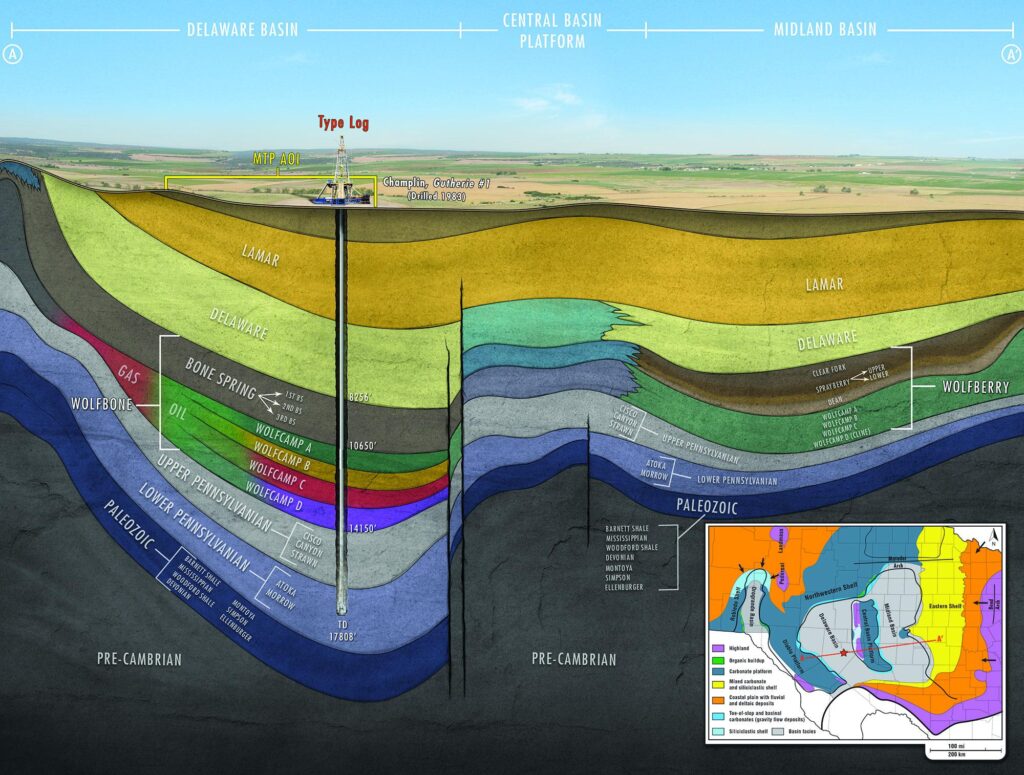The Permian Basin, spanning western Texas and southeastern New Mexico, is a cornerstone of U.S. oil and gas production. This region has long been a focal point for hydrocarbon extraction, and over the decades, water management has evolved significantly as produced water volumes have grown. Effective water management is not just about cost-effective water disposal, but about sustainable injection practices, minimizing environmental risk, and ensuring operation success and safety.
A Technical Perspective on Subsurface Pressure Changes
In the Permian Basin, injecting produced water into disposal wells was initially seen as a straightforward solution for managing the oil production byproduct. However, as production rose and hydraulic fracturing became prevalent, the volume of produced water injected into disposal zones increased substantially.
When water is injected into these disposal zones, the pressure increases (Figure 1a), mainly because no fluid is concurrently removed (unlike waterflooding operations, where oil, gas, and water are simultaneously produced). During active injection, a cone of pressure buildup develops at and away from the wellbore, the size and shape of which are dictated by a host of factors, including the injection rate, the injection history, properties of the water, well, and rock, and the presence of other active injection (pressure is additive among overlapping pressure cones (Figure 1b).

The consequences of increased subsurface pressure manifest into seismic events, challenging pressure dynamics when drilling new oil wells, and fluid confinement issues. These issues necessitated the development of more sophisticated formation pressure management techniques for injection-receiving geologic intervals throughout the Permian Basin.
Techniques for Monitoring and Controlling Subsurface Pressure
Pressure Monitoring
- Bottomhole Pressure Gauges: Continuous data from bottomhole pressure gauges provide real-time insights into reservoir conditions, enabling timely operational adjustments. In 2023, the Texas RRC added new requirements for certain new disposal wells, including all new deep disposal wells in the Permian Basin, and all new Shallow wells operating in a Seismic Response Area. These new wells will be required to be equipped and operated with a bottomhole pressure monitoring gauge.
- Surface Injection Pressure Monitoring: Regular monitoring of surface injection pressures helps operators understand pressure dynamics and prevent over-pressurization. Surface pressure can be affected by various construction and operational factors and does not provide complete insight into the workings of the subsurface, but it is a useful input when assessing injection performance.
Advanced Modeling
- Geomechanical Models: These models simulate the behavior of rock formations under various pressure conditions, helping understand injectivity and predict potential issues like fault reactivation and induced seismicity.
- Machine Learning Models: Predictive models use historical data to forecast pressure gradients and identify high-risk zones for over-pressurization. ConocoPhillips has adopted machine learning techniques to effectively predict and manage pressure changes, allowing for proactive adjustments.
Operational Adjustments
- Controlled Injection Rates: Regulating the water or gas injection rate maintains optimal pressure levels in the reservoir, minimizing the risk of over-pressurization and seismic events. Occidental Petroleum’s implementation of controlled injection rates has proven effective in managing subsurface pressures.
- Reservoir Management: Pre-injection step rate tests and injectivity tests help to assess the reservoir prior to injection and adjust daily V&P rates to optimize their reservoir management practices, ensuring sustained production and safety
A great example of a company implementing advanced pressure management techniques is Chevron. The company can better understand where resources are located by utilizing advanced mapping tools. This lets it concentrate on the most promising opportunities while minimizing risk.
“Our proprietary modeling tools use machine learning and artificial intelligence to choose the best spacing for our wells. These tools also help us understand the best way to prepare a well for production, decreasing development costs.” Chevron, 2023
Applying the Lessons Learned
The lessons from successful subsurface pressure management in the Permian Basin can be applied by operations throughout the industry, no matter the size.
- Comprehensive Monitoring: Implementing continuous pressure monitoring through bottomhole gauges and surface injection pressure systems is crucial for real-time data collection and operational adjustments.

B3 Insight’s OilfieldH2O - Advanced Modeling: Geomechanical and machine learning models can help predict pressure changes and identify high-risk areas, enabling proactive management. Tools such as B3’s OilfieldH2O and SIP, which have the largest and most widely used collection of comprehensive data, can help maximize the value of pressure monitoring.
- Collaborative Efforts: Sharing data, operational coordination, and socializing best practices among operators can facilitate a unified approach to pressure management, enhancing overall basin health. Efforts such as the Permian Strategic Partnership (PSP) is an example of the dedication to address current and future challenges and include industry leaders such as Halliburton, Phillips66, and Apache.
- Regulatory Compliance: Working closely with regulatory bodies to ensure compliance with local regulations and incorporating their feedback into operational practices is essential.
Permian Basin operators have mobilized significant resources and collaborated to tackle critical subsurface pressure challenges and their work remains ongoing. By integrating advanced monitoring technologies, high-quality data, predictive modeling, and collaborative efforts, operators can effectively mitigate the risks associated with over-pressurization and induced seismicity. The success stories of companies like Chevron and others underscore the importance of data-driven approaches in enabling smarter, more sustainable water management practices in the oil and gas industry.




